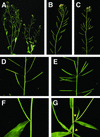The interaction of two homeobox genes, BREVIPEDICELLUS and PENNYWISE, regulates internode patterning in the Arabidopsis inflorescence
- PMID: 12897247
- PMCID: PMC167164
- DOI: 10.1105/tpc.012856
The interaction of two homeobox genes, BREVIPEDICELLUS and PENNYWISE, regulates internode patterning in the Arabidopsis inflorescence
Abstract
Plant architecture results from the activity of the shoot apical meristem, which initiates leaves, internodes, and axillary meristems. KNOTTED1-like homeobox (KNOX) genes are expressed in specific patterns in the shoot apical meristem and play important roles in plant architecture. KNOX proteins interact with BEL1-like (BELL) homeodomain proteins and together bind a target sequence with high affinity. We have obtained a mutation in one of the Arabidopsis BELL genes, PENNYWISE (PNY), that appears phenotypically similar to the KNOX mutant brevipedicellus (bp). Both bp and pny have randomly shorter internodes and display a slight increase in the number of axillary branches. The double mutant shows a synergistic phenotype of extremely short internodes interspersed with long internodes and increased branching. PNY is expressed in inflorescence and floral meristems and overlaps with BP in a discrete domain of the inflorescence meristem where we propose the internode is patterned. The physical association of the PNY and BP proteins suggests that they participate in a complex that regulates early patterning events in the inflorescence meristem.
Figures








Similar articles
-
Arabidopsis inflorescence architecture requires the activities of KNOX-BELL homeodomain heterodimers.Planta. 2006 Oct;224(5):1163-73. doi: 10.1007/s00425-006-0298-9. Epub 2006 Jun 2. Planta. 2006. PMID: 16741748
-
BLADE-ON-PETIOLE1 and 2 regulate Arabidopsis inflorescence architecture in conjunction with homeobox genes KNAT6 and ATH1.Plant Signal Behav. 2012 Jul;7(7):788-92. doi: 10.4161/psb.20599. Epub 2012 Jul 1. Plant Signal Behav. 2012. PMID: 22751300 Free PMC article.
-
VAAMANA--a BEL1-like homeodomain protein, interacts with KNOX proteins BP and STM and regulates inflorescence stem growth in Arabidopsis.Gene. 2004 Mar 17;328:103-11. doi: 10.1016/j.gene.2003.12.033. Gene. 2004. PMID: 15019989
-
KNOX homeobox genes potentially have similar function in both diploid unicellular and multicellular meristems, but not in haploid meristems.Evol Dev. 2005 Jan-Feb;7(1):69-78. doi: 10.1111/j.1525-142X.2005.05008.x. Evol Dev. 2005. PMID: 15642091 Review.
-
Involvement of homeobox genes in early body plan of monocot.Int Rev Cytol. 2002;218:1-35. doi: 10.1016/s0074-7696(02)18010-7. Int Rev Cytol. 2002. PMID: 12199516 Review.
Cited by
-
ATH1 and KNAT2 proteins act together in regulation of plant inflorescence architecture.J Exp Bot. 2012 Feb;63(3):1423-33. doi: 10.1093/jxb/err376. Epub 2011 Dec 3. J Exp Bot. 2012. PMID: 22140242 Free PMC article.
-
KNOX gene function in plant stem cell niches.Plant Mol Biol. 2006 Apr;60(6):929-46. doi: 10.1007/s11103-005-4478-y. Plant Mol Biol. 2006. PMID: 16724262 Review.
-
ramosa2 encodes a LATERAL ORGAN BOUNDARY domain protein that determines the fate of stem cells in branch meristems of maize.Plant Cell. 2006 Mar;18(3):574-85. doi: 10.1105/tpc.105.039032. Epub 2006 Jan 6. Plant Cell. 2006. PMID: 16399802 Free PMC article.
-
The role of PENNYWISE and POUND-FOOLISH in the maintenance of the shoot apical meristem in Arabidopsis.Plant Physiol. 2011 Jun;156(2):605-14. doi: 10.1104/pp.110.171462. Epub 2011 Apr 19. Plant Physiol. 2011. PMID: 21505100 Free PMC article.
-
Roles of lignin biosynthesis and regulatory genes in plant development.J Integr Plant Biol. 2015 Nov;57(11):902-12. doi: 10.1111/jipb.12422. J Integr Plant Biol. 2015. PMID: 26297385 Free PMC article. Review.
References
-
- Cline, M.G. (1994). The role of hormones in apical dominance: New approaches to an old problem in plant development. Physiol. Plant. 90, 230–237.
-
- Cutter, E.G. (1971). Plant Anatomy: Experiment and Interpretation. (London: Edward Arnold).
-
- Digby, J., and Wareing, P.F. (1966). The effect of applied growth hormones on cambial activity and the differentiation of the cambial derivatives. Ann. Bot. 30, 539–548.
Publication types
MeSH terms
Substances
Associated data
- Actions
- Actions
- Actions
Grants and funding
LinkOut - more resources
Full Text Sources
Other Literature Sources
Molecular Biology Databases
Research Materials

